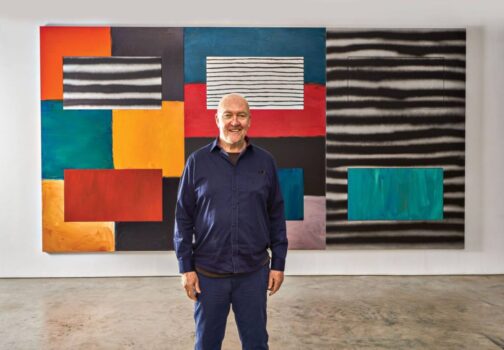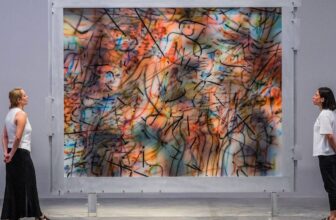Sean Scully’s Famous Paintings
Sean Scully’s paintings have an unmistakable presence. Often monumental in scale, they radiate quiet strength, rhythm, and a sort of meditative tension. His signature blocks and bands of color, sometimes stark, sometimes tender, are not mere geometry; they are emotional landscapes, repositories of memory, and reflections on human experience. Over decades, Scully has built an artistic language that bridges the minimalism of the late 20th century with deeply personal expression.
This is the story of who Sean Scully is, the art he’s made, how he creates it, what makes it valuable, and where in the world you can find his works today.
Who Is Sean Scully and What Is He Known For?
Sean Scully was born in Dublin, Ireland, in 1945, but grew up in London. His childhood was marked by hardship, his family struggled financially, and art was not an obvious career path. Yet, from a young age, he felt drawn to visual forms, particularly the patterns and colors he saw around him.
In the 1970s, Scully moved to the United States and eventually became a U.S. citizen, splitting his life between Europe and America. His career took off in the late 1970s and early 1980s, when he began refining the visual language he is now known for: broad horizontal and vertical stripes, squares, and rectangles in textured layers of color.
What Scully is Known For:
Abstract stripe paintings with emotionally charged color palettes.
Bridging Minimalism and Abstract Expressionism, pairing order and geometry with painterly depth.
Large-scale works that dominate space yet invite intimate contemplation.
Exploration of memory, spirituality, and place through abstract form.
International presence, with exhibitions and collections across the globe.
Sean Scully’s Famous Paintings
While Scully has produced hundreds of paintings across decades, several works have become particularly well-known:
1. “Wall of Light” Series
Inspired by sunlight hitting ancient stone walls in Mexico, these paintings translate the physicality of masonry into blocks of layered color. The series has variations in oil, watercolor, and pastel.
2. “Backs and Fronts” (1981)
A monumental work over 20 feet long, this piece established Scully’s mature style, vertical and horizontal panels of varying widths and colors. It marked his breakthrough moment at the Guggenheim Museum.
3. “Catherine” (1979)
Named after his first wife, this is a more restrained, monochromatic work from his early stripe phase, hinting at the emotional depth behind his later color-rich canvases.
4. “Passenger” Series
Paintings inspired by travel, migration, and the feeling of moving through different places, often with shifting bands and softened edges.
5. “Human” (2018)
A deeply personal piece, blending rough-hewn geometry with rich reds and blacks, a tribute to resilience and humanity.
How Much Do Sean Scully Paintings Cost?
Scully’s works are among the most sought-after in contemporary abstract painting. Prices vary based on size, medium, provenance, and whether the piece is from a major series.
Auction Records and Market Trends:
Smaller works on paper or limited edition prints: $20,000–$80,000.
Mid-size paintings: $500,000–$1.5 million.
Monumental canvases from iconic series: $1.5 million–$3 million+.
Auction record: In 2018, Wall of Light Orange sold for around $2.3 million at Sotheby’s.
The high value reflects not only his international acclaim but also the physical and emotional depth of his works, collectors see them as both aesthetic treasures and cultural investments.
How Does Sean Scully Make His Paintings?
Sean Scully’s painting process is deliberate, layered, and physical. He is not a minimalist who stops at flat color; he works with paint like a sculptor with stone.
Step-by-Step Overview of His Process:
Surface Preparation:
Scully often paints on large-scale linen or canvas, primed with gesso. He prefers sturdy, absorbent surfaces.Layering the Base:
He begins with underpainting, sometimes in colors that will only peek through later layers, creating visual depth.Marking the Structure:
Using tape, pencil, or freehand, he outlines the bands, blocks, and divisions.Applying Paint in Layers:
Oils are applied in broad strokes, with variations in opacity. He often uses both brushes and palette knives to create texture.Building Depth Through Overpainting:
Colors are layered repeatedly, sometimes scraped back, to let earlier tones ghost through.Final Adjustments:
Scully adjusts edges so they are not mechanically perfect, this human irregularity is central to his emotional abstraction.
How Many Paintings Does Sean Scully Have?
While there is no official published number, Scully has been painting consistently for over five decades. Including large-scale oils, works on paper, watercolors, pastels, and prints, the total number of pieces is estimated in the thousands.
The Wall of Light series alone spans more than 200 works across various media. He has also created sculptures and photographs, though paintings remain the core of his output.
What Art Style Is Sean Scully Associated With?
Scully’s style defies a single label, but he is most often associated with:
Abstract Painting: His works are entirely non-representational.
Minimalism with a Human Touch: While his work shares Minimalism’s geometric rigor, it rejects its cold impersonality.
Color Field Painting: Large areas of color dominate his canvases, though unlike Rothko’s soft clouds, Scully’s colors are bounded by structure.
Lyrical Abstraction: His work often conveys mood, atmosphere, and narrative through non-representational forms.
He is often compared to Rothko, Barnett Newman, and Mondrian, but his tactile surfaces and earthy tones set him apart.
What Materials Does Sean Scully Use?
Scully primarily works in:
Oil paint (his preferred medium for its richness and flexibility).
Linen and cotton canvas for large works.
Pastel and watercolor for smaller works and preparatory studies.
Graphite and charcoal for drawings.
Wood and metal in some sculptural works.
Mixed media in certain experimental pieces.
His color palette often includes deep reds, ochres, blacks, and blues, inspired by landscapes, architecture, and personal memories.
Where Are Sean Scully’s Paintings Located?
Scully’s work is represented in major museum collections and public spaces worldwide, including:
United States
Museum of Modern Art (MoMA), New York
Metropolitan Museum of Art, New York
Guggenheim Museum, New York
National Gallery of Art, Washington, D.C.
Europe
Tate, London
Centre Pompidou, Paris
Museo Nacional Centro de Arte Reina Sofía, Madrid
Hungarian National Gallery, Budapest
Other Regions
National Gallery of Australia, Canberra
Irish Museum of Modern Art, Dublin
Various private collections worldwide
His large-scale public installations can also be found in airports, universities, and corporate buildings.
The Emotional and Cultural Significance of Scully’s Work
While Scully’s paintings may look like simple stripes at first glance, they are loaded with personal history. The uneven edges, the visible brushstrokes, the way colors interact, all speak to his belief that abstraction can carry as much emotion as figurative painting.
He has spoken about painting as a form of resistance against the speed and disposability of modern life. In an age of digital images, his canvases demand time and physical presence.
Why Collectors and Museums Value Scully
Sean Scully occupies a unique space in the art market:
Historical Importance: He is seen as one of the most important abstract painters since the mid-20th century.
Consistency: His work has evolved but retained a recognizable identity.
Scale and Presence: Large works transform spaces, making them ideal for museums and high-profile collections.
Emotional Resonance: They are not cold exercises in geometry, they have warmth and narrative.
The Legacy of Sean Scully
Sean Scully’s journey, from working-class London boy to internationally celebrated artist, mirrors the arc of modern abstraction itself: rigorous, boundary-pushing, and deeply human. His paintings are not just colored stripes; they are built spaces for contemplation, memory, and connection.
Today, whether hanging in the Tate, looming in a New York gallery, or resting in a private collector’s home, Scully’s works continue to speak in their quiet but commanding language.
They remind us that even in the most minimal forms, there is room for complexity, intimacy, and the infinite shades of human experience. image/ Michael Mundy




